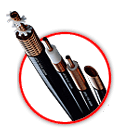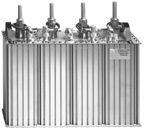
Many years ago.......
while serving in the U.S. Military, I
took it upon myself to learn as much as possible about the country in
which I was stationed. One of my favorites was Germany where work
ethic was based on a centuries old tradition of being the best you could
be at whatever you did. When you attained the status of best at
what you did, you were known as a Meister (or Master, in
English). A Meister was, and presumably still is, a position of
respect in which a shoemaker, a mechanic, or physician were all afforded
equal status. In the US, we once had a similar term called Master
Craftsman.
Before the days of international
corporations, mega mergers, and a sole objective of making maximum
profits, there were actually companies like The Bell System, J.C. Penny,
Zenith, and others who understood and promoted the relationship between
their company, their customers, their suppliers, their employees, and
their community. Advancement of technology, profitability and
lowering prices is, or at least should be, a primary objective of any
business endeavor, but not the ONLY objective. That is why we have
a great deal of respect for some of our Canadian neighbors. The
core values of companies like Daniels Electronics and Sinclair
Technologies fit the mold for the kind of supplier that meets our
criteria for technological achievements coupled with corporate
responsibility. We think they are in the Meister
class. Sinclair is our supplier of
choice for antenna systems. The products broadly classed as antenna
systems generally consist of the antenna, the transmission line,
lightning protection devices, and devices known as combiners, duplexers,
and multicouplers to maximize efficiency and minimize cost. We
would like to take this opportunity to introduce you to the products
that make up an antenna system, in particular as they relate to fixed base station products.
 |
 |
 |
Pictured at the left are
our three most popular commercial base station antennas. The two
antennas at the far left are known as collinear whereas the one on
the right is called an open dipole type. The collinear types
are best suited for use with portables whereas the open dipole
type has greater mechanical integrity. Either can be
expected to have a useful life of up to 20 years. The VHF
antennas have a gain factor of approximately 4X the power of the
transmitter (i.e. a 100 watt transmitter has an effective power of
400 watts). The UHF antennas have a gain of 10X (a 100 watt
transmitter has an ERP of 1000 watts). The same gain factor
is applicable to the received signal from a handheld
radio. Our personal favorite is the Sinclair RM201
(VHF) shown in the middle. For detailed specifications,
click on the antenna images at the left. The price is the
same for all antennas - $1,095. |
|

|
Once the antenna has been selected, the
antenna will have to be mounted. In most cases, the antenna
is side mounted on an existing tower such as the one shown at the
left. The cost of a side mount bracket assembly is $200
for either a tower, telephone pole or water tank. On
average, you can figure a similar amount for local installation in
the Birmingham, Alabama area. Outside the Birmingham metro
area, assume $300 north of Montgomery to the Tennessee line or
$400 south of Montgomery to the Gulf of Mexico. If you need
to construct a tower, assume a materials cost of $250 per 10'
section for tower sections, guy wires, and accessories.
Installation, excluding concrete will average $100 per section in
the Birmingham metro area. Add $25 north of Montgomery or
$50 south of Montgomery, Alabama.
|
|

|
Transmission line is used to connect the
antenna to the associated base station. Our preference is
known as Heliax. It was developed in the USA by the Andrew
Corporation and it is the standard for the world in communications
transmission line. We recommend 1/2" Heliax for
lengths of up to 150 feet at a cost of $2.50 per foot plus $75 for
the required connectors. For runs between 151 and 250
feet, we recommend 5/8" Heliax at a cost of $4.00 per foot
plus $100 for connectors. For lengths of 250 feet to no more
than 350 feet, we recommend 7/8" cable at $5.50 per foot plus
$125 for connectors. For lengths over 350 feet, call us at
1.800.489.2611 for a quote.
|
|

|
To protect base station equipment, we use a
coaxial high voltage suppressor. The best in the business
happens to be made in the USA by Polyphaser. The
Polyphaser provides lightning protection on the transmission
cable. Direct lightning strike damage caused by entry through
the antenna feed line is greatly reduced by adding this low cost
$69 device. One Polyphaser is used for each antenna
connected to an associated transmitter or receiver. This
brings us to the subject of antenna planning. We normally provide
these with an N female connector to mate with the transmission
line and an N male to mate with the associated radio.
|
|

|
A
base station requires only a single antenna since an
antenna switch provides the function of switching from the
transmitter to the receiver depending on the activation of the
associated microphone. A repeater station must keep
the transmitter and receiver active simultaneously. There
are two ways to address this requirement. You could use two
antennas but the more acceptable procedure is to use a duplexer
such as the Sinclair Q2222. This is basically a filter that
allows the transmitter and receiver to operate simultaneously with
minimum effect. The price of a duplexer is based on the
separation between the antennas, the filtering desired, and
acceptable signal loss. The best duplexer for the money,
in particular when handheld radios are involved, is the Q2222
(VHF) priced at $1,295. The UHF model is the same
price. Click on the photo at the left for more information.
|
|

|
The device at the left is an internal view of a device known as a Combiner.
The function of a combiner is to allow multiple transmitters
to feed into a single antenna. If you have more than one VHF
or UHF station, a combiner can be a wise investment since you can
eliminate the cost of additional antennas and transmission lines
while simultaneously improving performance in many cases. In
general, a combiner is most efficient when connected to four
transmitters or less. The actual cost will vary depending on
the frequencies to be used but for budgetary purposes, you can
assume a cost of $1,500 per channel for a good quality combiner
such as the Sinclair TC2214.
|
|

|
A Multicoupler is a device that allows multiple receivers
to be fed into a single antenna. By using a Combiner for
transmitters, and a Multicoupler used for receivers, up to four
VHF or UHF radios can be connected to only two antennas. In
addition to saving the expense of running multiple transmission
lines and the cost of the antennas, performance is enhanced by reducing
interactive effects between the antennas. In the case of the
Multicoupler, talk-back range of mobiles and portable radios is
actually improved since the Multicoupler contains an amplification
stage than is not applicable in a duplexer or even in a direct
antenna connection. A four channel Multicoupler such as
the Sinclair RM201 is $1,800.
|
I hope you have find this information useful in
gaining a better understanding of the components used in a properly
planned antenna system. Obviously, there are other products and
other alternatives for system planning. However, in the majority
of the application, the products listed above represent good choices in
a balance of performance, quality, and long term overall cost. The
products listed above are well suited for use with Daniels, ICOM,
Midland, Motorola, & Relm/BK base stations and repeaters. If
you have any questions, or if we can be of service in any way, please
give me a call, personally at 1.800.489.2611. We look forward to
serving you!
Burch H. Falkner
At your Service!
|


